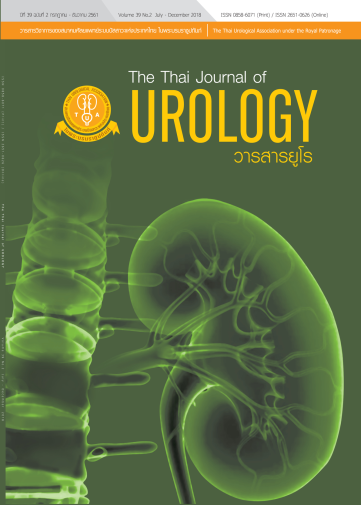Quality of life in pediatric patients with lumbosacral myelomeningocele compare to normal children
Keywords:
Quality of life, Lumbosacral, Myelomeningocele, Children, Care giverAbstract
Objective: The aim of this study was to assess the health-related quality of life of patients and explore the factors that are associated with the quality of life in patients with lumbosacral myelomeningocele.
Material and method: The cross-sectional design study was conducted between January 2017 and December 2017. The questionnaires were given to patients aged 13 – 18 years of age and their care givers, and to parents of patients between 2 and 12 years. A second group of age matched people were given questionnaires as a control group. Patient’s health-related quality of life (HRQOL) was examined using The Pediatric Quality of Life Inventory™ (PedsQLTM) 4.0 Generic Core Scale (Thai version). The data of patients and controls were collected, compared and analysed.
Result: The mean quality of life scores of the patients with lumbosacral myelomeningocele were lower in the case of physical, emotional, social and school functioning in comparison to the scores recorded by the control group. The reductions were most marked in the factors referring to education, bladder function, bowel function, ambulation and caregiving.
Conclusion: Patients with myelomeningocele often require assistance in many aspects of their life. Caring for their physical, emotional, and social needs and their ability to function at school is important.
References
2. Chambers GK, Cochrane DD, Irwin B, Arnold W, Thiessen PN. Assessment of the appropriateness of services provided by a multidisciplinary meningomyelocele clinic. Pediatr Neurosurg 1996;24:92e7.
3. AuKS, Ashley-KochA, Northrup H. Epidemiologic and genetic aspects of spina bifida and other neural tube defects. Dev Disabil Res Rev 2010;16:6e15.
4. Roszkowski M, Skobejko L, Barszcz S. The tethered spinal cord: diagnosis and surgical considerations. Pediatr Pol 1996;71:135-41.
5. McClugage SG, Watanabe K, Shoja MM, Loukas M, Tubbs RS, Oakes WJ. The history of the surgical repair of spina bifida. Childs Nerv Syst 2012;28:1693-700.
6. Anutrakulchai W, Mahawong P, Anutrakulchai S. Neurogenic lower urinary tract dysfunction in pediatric lumbosacral myelomeningocele. Thai J Urol 2011;32:14-21.
7. Varni JW, Burwinkle TM, Lane MM. Health-related quality of life measurement in pediatric clinical practice: an appraisal and precept for future research and application. Health Qual Life Outcomes 2005;3:34.
8. Varni JW, Seid M, Rode CA. The PedsQL: measurement model for the pediatric quality of life inventory. Med Care 1999;37:126-39.
9. Varni JW, Seid M, Kurtin PS. PedsQL 4.0: reliability and validity of the Pediatric Quality of Life Inventory version 4.0 generic core scales in healthy and patient populations. Med Care 2001;39:800-12.
10. Varni JW, Seid M, Knight TS, Uzark K, Szer IS. The PedsQL 4.0 Generic Core Scales: sensitivity, responsiveness, and impact on clinical decision-making. J Behav Med 2002;25:175-93.
11. Varni JW, Limbers CA. The PedsQL 4.0 Generic Core Scales Young Adult Version: feasibility, reliability and validity in a university student population. J Health Psychol 2009;14:611-22.
12. Varni JW, Burwinkle TM, Seid M, Skarr D. The PedsQL 4.0 as a pediatric population health measure: feasibility, reliability, and validity. Ambul Pediatr 2003;3:329-41.
13. Chan KS, Mangione-Smith R, Burwinkle TM, Rosen M, Varni JW. The PedsQL: reliability and validity of the short-form generic core scales and Asthma Module. Med Care 2005;43:256-65.
14. Kochakarn W, Ratana-Olarn K, Lertsithichai P, Roongreungsilp U. Follow-up of Long-term Treatment with Clean Intermittent Catheterization for Neurogenic Bladder in Children. Asian J Surg 2004;27:134-6.
15. Kelly LM, Zebracki K, Holmbeck GN, Gershenson L. Adolescent development and family functioning in youth with spina bifida. J Pediatr Rehab Med 2008;1:291-302.
16. Vermaes IP, Gerris JR, Mullaart RA, Geerdink N, Janssens JM. PMTS and stress response sequences in parents of children with spina bifida. Eur J Paediatr Neurol 2008;12:446-54.
17. Achilles GM, McLaughlin MJ, Croninger RG. Sociocultural correlated of disciplinary exclusion among students with emotional, behavioral, and learning disabilities in the SEELS National Dataset. J Emot Behav Disord 2007;15:33-45.
18. Okurowska-Zawada B, Kulak W, Otapowicz D, Sienkiewicz D, Grazyna-Patej, Wojtkowski J. Quality of Life in Children and Adolescents with Cerebral palsy and Myelomeningocele. J Pediatr Neurol 2011;04.006.



